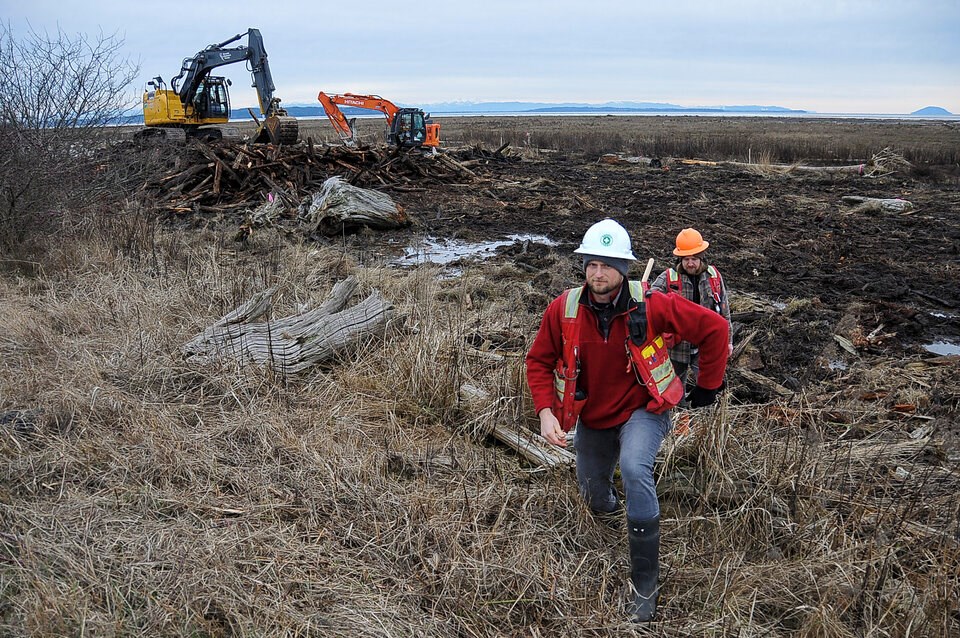Along the southern reaches of Metro Vancouver, a dike protects the Boundary Bay Airport, a golf course and wide stretches of farmland, homes and businesses that make up the City of Delta.
Over the next 70 years, global warming is expected to here, as climbing temperatures melt many of the world’s ice shelves into the sea and ocean volumes expand. To keep up, dike improvements could cost the region $9.5 billion by 2100, according to one .
As the financial costs of climate change climb, experts and governments are quickly coming to the consensus that man-made structures won't be enough to protect coastal communities.
For biologist Dan Stewart, the answer is obvious, and on a recent overcast day, he was looking at it: from the edge of the Boundary Bay dike, a more than 200 metre-thick band of salt marsh reached out to the sea.
“I've witnessed it first-hand during storm events,” said Stewart.
“These marshes really provide a buffer between the marine environment and the dike.”
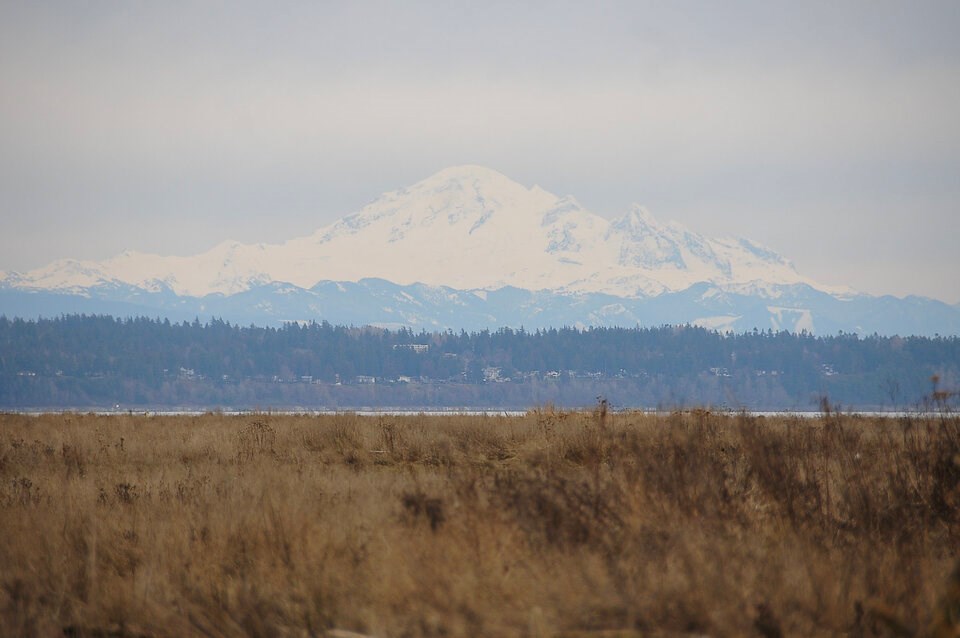
What's left of the Fraser River delta’s 17,000 hectares of has been slowly eroded by shoreline development on one side and a lack of new silt and clay on the other. Only remnants of a vast estuary ecosystem that emerged at the end of the last ice age remain. And as sea levels rise, they could get increasingly swallowed up.
Despite the losses, Metro Vancouver's wetlands remain the most important stop-over site for migrating birds in Western Canada — their importance made even more acute at a time when 100 species of birds across the region are facing less than a 50 per cent chance of survival over the long run, according to Birds Canada’s James Casey, a Fraser River estuary specialist.
Like mangrove forests and beds of sea grass, salt marshes are the ultimate multi-taskers. They are particularly good at sucking up large quantities of carbon dioxide from the atmosphere. When the plants of a salt marsh die, they get buried in the muck; their carbon-filled roots and stems lock into the muddy layers.
As the years go on, more marsh plants grow on top of the dead ones, forming one of the world’s greatest natural carbon sinks. But to grow and bury more carbon-rich plants requires more mud.
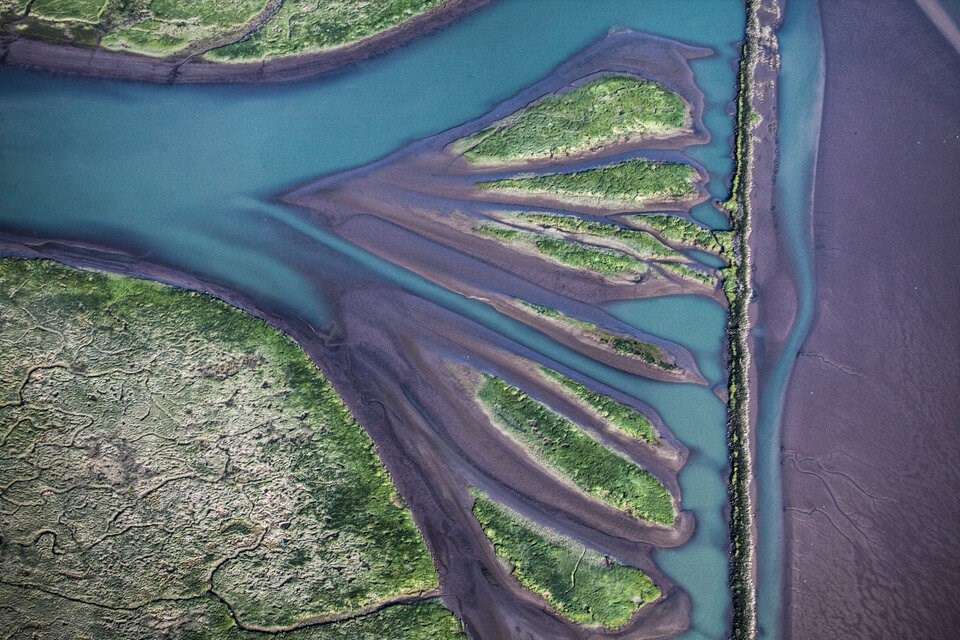
For most of the last 10,000 years, the Fraser River has provided that mud supply, delivering 20 million tonnes of sand and silt into the sea every year. Over the years, this process has slowly help build Sea Island — now home to Vancouver International Airport — and the land the cities of Richmond and Delta now occupy.
Over the last century, that natural system has been disrupted: in an effort to control the shifting river delta, humans have hardened shorelines, built jetties and dredged the riverbed.
But like dikes, that hard infrastructure is expensive and often impractical to continuously upgrade in a world where sea level rise poses an existential threat to coastal communities. Salt marshes, on the other hand, offer a that governments at all levels say they are counting on to guard against rising seas.
The thicker and healthier the salt marsh, the more protection they provide. The only problem: they're dying.

Removing the ‘rolling pins’
Under an overcast sky, orange and yellow excavators teeter on piles of driftwood, their claws racking a path in the marsh next to the Boundary Bay dike. The two heavy machines are there as part of a federally backed project run by Ducks Unlimited Canada to restore salt marshes and boost their ability to store carbon.
Seen from space, satellite images that should reveal marsh show rafts of driftwood — a byproduct of the countless log booms breaking up and floating ashore over the years.
Two days after Christmas last year, an unusually high “king tide” rose water levels in the marsh. When the water hit the dike, it had nowhere to go. In a time-lapse video, Stewart captured the vast rafts of saw logs floating off the marsh floor.
“Once they're in here, it’s essentially a trap,” he said.
With their branches and root wad removed, “they just spin,” Stewart added, crushing the plants, animals and whatever life had managed to spring up between the raft of wood.
Among that life is the endangered ; in Canada, it's only found in a few small pockets on the shores of Metro Vancouver and Greater Victoria.
“This side of the Strait of Georgia, this is the only place where it's been found, this strip of Boundary Bay” said Stewart.
As a biologist who specializes in the ecosystems of the Fraser delta, Stewart was contracted to keep an eye on the log removal.
Some workers removed discarded construction materials and busted-up creosote pilings from the clean wood. Stewart picked through the driftwood; he marked off logs with pink ribbon so the excavator operators knew to leave them in place as habitat for birds, insects and small mammals.
“It's not as simple as like villainizing wood. Wood is a natural part of marsh ecosystems and to perfectly clean it and pretend that wood isn't a part of it is naive,” Stewart said.
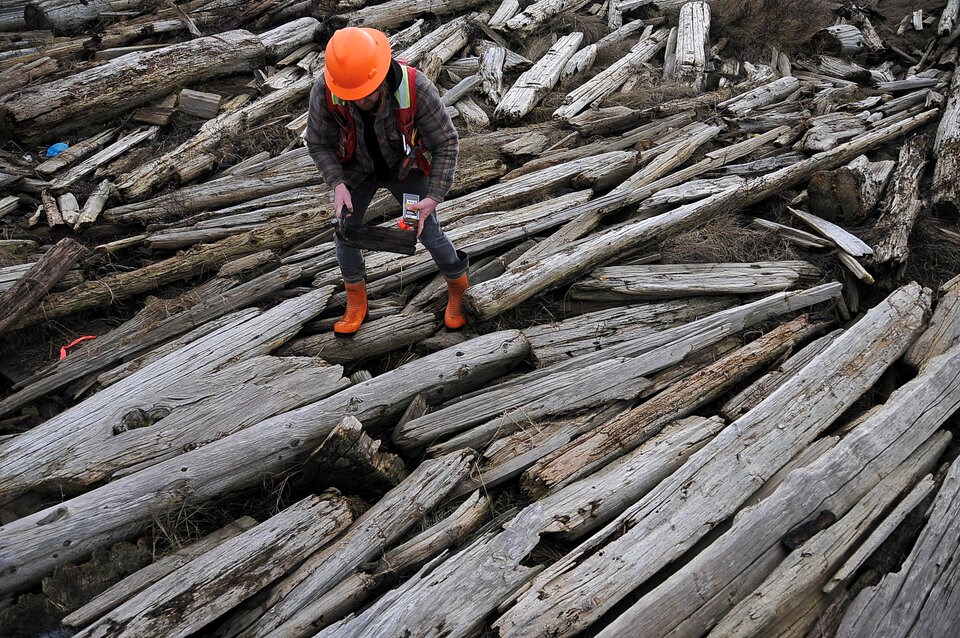
He pointed to a smooth log with clean ends, likely from the forestry sector.
“I like it because it's really, really fat. And I could see a shrub and vegetation establishing on it. I could see an animal using it as a refuge,” he added. “But the tiny toothpick logs from the forestry sector? They’re extremely damaging to these marshes.”
The removal, which is backed by the Nature Smart Climate Solutions Fund, a pot of money meant to help Canada reduce its greenhouse gas emissions using natural climate solutions, is expected to continue for several days. Once completed, Stewart says they will plant some arrow grass, pickle weed and a handful of other salt marsh species that can adapt to the conditions.

Within five years, the biologist says he expects sedges, grasses and the animals that come with them to move back into the area. By then, he says, the area will be indistinguishable from the surrounding marsh.
What should concern local residents, he added, is not a temporary scar on the landscape, but the near endless supply of human-modified logs that float in and suffocate a number of other sites across the lower Fraser's salt marshes.
“There might be a few years where it might look a little ugly in here,” he warned. “But to look back 300 years ago or pre-colonization, that's no longer our target for restoration,” said Stewart.
“When habitat is so limited already, and we have declining salmon… I think we have to ask ourselves, what is our role to play in managing these ecosystems? Is it to be entirely hands-off and hope for the best or is it to acknowledge that maybe we have a role to play?”

Rebuilding marsh from scratch
Eric Balke pulled out a satellite map and pointed to ripples in the sand off the west coast of Richmond.
“These are remnant islands of vegetation,” said the senior restoration biologist for Ducks Unlimited.
At the mouth of the Fraser River, at least 240 hectares of tidal marsh have died off since the 1980s. In some places, like Sturgeon Bank, that’s meant the marsh land has receded between 200 and 700 metres from the sea.
“It’s just massive,” Balke said. “Nobody is quite sure why.”

Balke says part of the problem is likely hardened coastlines, which have prevented much of the river sediment from settling where it naturally would.
Later this month, he and a team of contractors will take a dredging vessel, filled with sediment pulled up from the river bottom, and steam it over to Sturgeon Bank.
Usually, most of that sediment is dumped out at sea. Instead, the group will assemble a series of pipes, and through them, pump 13,000 cubic metres of dredged sediment over 40 hectares near Sturgeon Bank. The slurry will be shot through a specially designed spoon-shaped nozzle that’s meant to fan out a platform new salt marshes can grow on.
Fraser River Pile and Dredge, which Ducks Unlimited contracted to help on the project, has already tested the “spoon” at a site in south Richmond.
“The Fraser River just kind of snaked around like a big ol fire hose — unrestrained,” said Balke. “What we're trying to do is to add sediments in a way that mimics those natural processes.”
Balke says the team has carefully studied similar projects in the Mississippi River delta, and the group is using the same “mud motor” that’s already been tested in the Netherlands.
And while some overseas projects have proved successful, none have been carried out on the Fraser, where different plants and freshet snow melts lead to a different river dynamic, Balke added.
To improve the chances of not losing the sediment to the sea as the tides rise and fall, the team from Ducks Unlimited Canada plans to build crescent-shaped sand berms that will direct the finer silts and clays inland.
Backed by the provincial and federal governments through the Salmon Restoration and Innovation Fund, the group has spent years designing the two-year pilot project.
If it works, Balke says he foresees a kind of ongoing marsh maintenance program offering a soft human touch to help wetlands thrive in the same way arborists care for urban trees.
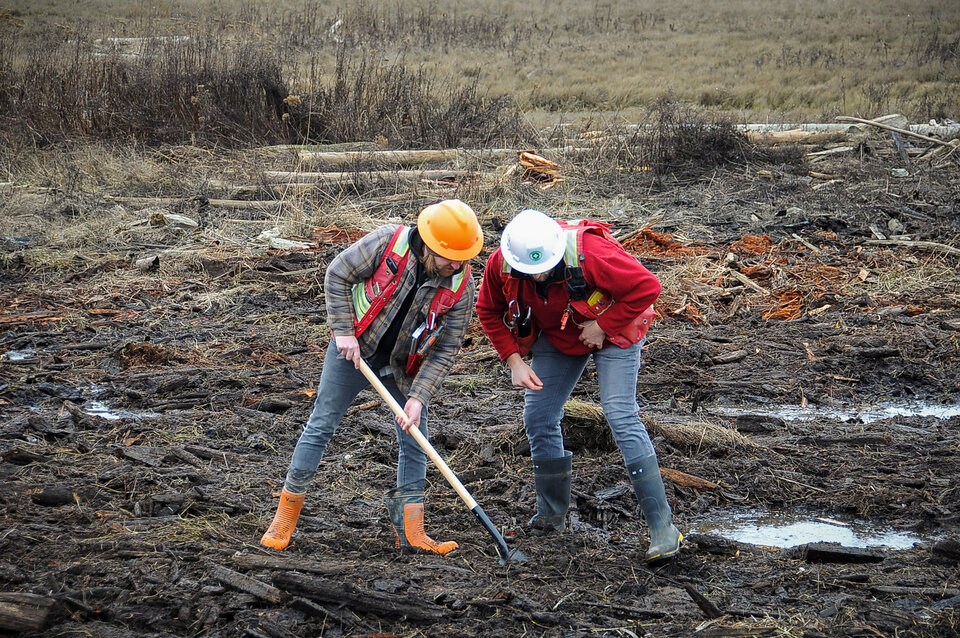
Impact 'for the better'
Balke says the pilot project will cost somewhere around $2 million. To scale up the building of new marshes or the removal of logs from existing marshes, Balke says many are looking to the “polluter pays” model.
If forestry companies are going to inadvertently release rafts of woody debris along the shoreline, strangling salt marsh growth; if the port authority is going to permanently alter the Fraser River’s path, starving marshes of sediment, the thinking goes, shouldn’t they be part of the solution?
If this kind of a pilot is successful, Balke said it could be scaled up across the entire delta, protecting cities from sea level rise, removing atmospheric carbon and rebuilding habitat for juvenile salmon, birds and other creatures all at the same time.

Back at Boundary Bay, Balke and Stewart stood on the dike a hundred metres from the airport as a steady stream of airplanes buzzed overhead. Below him, the excavators had made surprisingly fast work clearing out the raft of saw logs and driftwood.
“It's all part of the lesson I think we're all learning locally — [we are] understanding our role as humans in this ecosystem. To be totally hands-off, I don't think is acceptable,” Stewart said.
“We're impacting it regardless, so why not impact it for the better based on the best science we have?”
